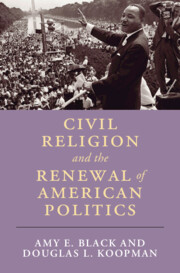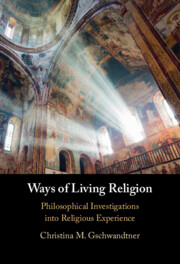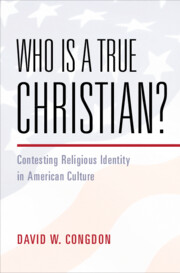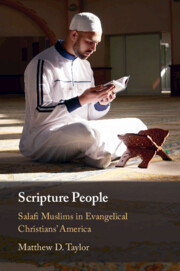Refine search
Actions for selected content:
47 results
4 - Protestantism and Its Pervasive Influence on Civil Religion
- from Part II - Religious Traditions
-
- Book:
- Civil Religion and the Renewal of American Politics
- Published online:
- 09 October 2025
- Print publication:
- 23 October 2025, pp 53-78
-
- Chapter
- Export citation
The Limits of Literalism: Race, The Bible, and The Desegregation of Dallas Theological Seminary, 1950–1980
-
- Journal:
- Church History , First View
- Published online by Cambridge University Press:
- 14 October 2025, pp. 1-22
-
- Article
-
- You have access
- Open access
- HTML
- Export citation

Civil Religion and the Renewal of American Politics
-
- Published online:
- 09 October 2025
- Print publication:
- 23 October 2025
5 - Women’s Networks
-
- Book:
- Christianity at the Crossroads
- Published online:
- 19 May 2025
- Print publication:
- 31 July 2025, pp 146-178
-
- Chapter
- Export citation
Asserting Protestant Legitimacy in a Catholic Context: Rhetorical Strategies of the Confederação Evangélica do Brasil, 1930s–1950s
-
- Journal:
- Church History / Volume 94 / Issue 2 / June 2025
- Published online by Cambridge University Press:
- 21 October 2025, pp. 321-337
- Print publication:
- June 2025
-
- Article
-
- You have access
- Open access
- HTML
- Export citation
Chapter 7 - Religious Reestablishment from Pulpit to Page
- from Part I - Concepts
-
-
- Book:
- The Cambridge Companion to Nineteenth-Century American Literature and Politics
- Published online:
- 06 March 2025
- Print publication:
- 13 March 2025, pp 125-142
-
- Chapter
- Export citation
The pacification model in Port-au-Prince and Rio de Janeiro as a prefiguration of Bolsonarismo? Reflections on the far-right turn and the role of military-religious actors in security governance in Brazil
-
- Journal:
- European Journal of International Security / Volume 10 / Issue 4 / November 2025
- Published online by Cambridge University Press:
- 16 January 2025, pp. 545-567
-
- Article
-
- You have access
- Open access
- HTML
- Export citation
“Is Humanism Molesting Your Child?” Lottie Beth Hobbs, the Death of the ERA, and the Birth of the Religious Right
-
- Journal:
- Church History / Volume 93 / Issue 3 / September 2024
- Published online by Cambridge University Press:
- 26 February 2025, pp. 565-586
- Print publication:
- September 2024
-
- Article
-
- You have access
- Open access
- HTML
- Export citation
Chapter 5 - American Spirituality
-
-
- Book:
- The Cambridge Companion to American Utopian Literature and Culture since 1945
- Published online:
- 09 May 2024
- Print publication:
- 16 May 2024, pp 100-114
-
- Chapter
- Export citation
Introduction
-
- Book:
- Ways of Living Religion
- Published online:
- 07 March 2024
- Print publication:
- 14 March 2024, pp 1-13
-
- Chapter
- Export citation
Reconceiving Christianity and the Modern Prison: On Evangelicalism’s Eugenic Logic and Mass Incarceration
-
- Journal:
- Journal of Law and Religion / Volume 39 / Issue 1 / January 2024
- Published online by Cambridge University Press:
- 11 March 2024, pp. 85-115
-
- Article
-
- You have access
- Open access
- HTML
- Export citation

Ways of Living Religion
- Philosophical Investigations into Religious Experience
-
- Published online:
- 07 March 2024
- Print publication:
- 14 March 2024
Christian Worldview and Cosmic War: Contexts and Origins of a Religious Combat Concept
-
- Journal:
- Church History / Volume 93 / Issue 1 / March 2024
- Published online by Cambridge University Press:
- 04 November 2024, pp. 63-84
- Print publication:
- March 2024
-
- Article
-
- You have access
- Open access
- HTML
- Export citation

Who Is a True Christian?
- Contesting Religious Identity in American Culture
-
- Published online:
- 04 January 2024
- Print publication:
- 22 February 2024
3 - Changing Cultures of Execution: Religion and Feeling, 1660–1770
-
- Book:
- Execution, State and Society in England, 1660–1900
- Published online:
- 12 October 2023
- Print publication:
- 26 October 2023, pp 63-93
-
- Chapter
- Export citation

Scripture People
- Salafi Muslims in Evangelical Christians' America
-
- Published online:
- 27 July 2023
- Print publication:
- 10 August 2023
Chapter 13 - The New Social Cleavage
- from Part IV - A Faustian Bargain?
-
- Book:
- The Godless Crusade
- Published online:
- 23 March 2023
- Print publication:
- 30 March 2023, pp 195-207
-
- Chapter
- Export citation
Chapter 15 - A Faustian Bargain?
- from Part IV - A Faustian Bargain?
-
- Book:
- The Godless Crusade
- Published online:
- 23 March 2023
- Print publication:
- 30 March 2023, pp 225-248
-
- Chapter
- Export citation
The Conservative Wave and Corporate Practices in Brazil: The Controversy over LGBTQ in Marketing
-
- Journal:
- Journal of Latin American Studies / Volume 55 / Issue 2 / May 2023
- Published online by Cambridge University Press:
- 15 March 2023, pp. 267-292
- Print publication:
- May 2023
-
- Article
- Export citation
Embodied world construction: a phenomenology of ritual
-
- Journal:
- Religious Studies / Volume 60 / Issue 1 / March 2024
- Published online by Cambridge University Press:
- 17 February 2023, pp. 103-122
- Print publication:
- March 2024
-
- Article
- Export citation
